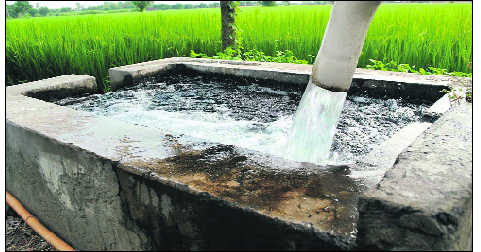‘Dry’ Punjab draws 1.5 times the water that goes in ground
Ruchika M Khanna
Tribune News Service
Chandigarh, August 9
The Punjab Government may have put on hold the release of new tubewell connections, but the dramatic rate of fall in the ground water level is likely to continue unabated as the existing tubewells annually draw one and a half times the amount of recharge.
As much as 77 per cent of the cultivable area in the state is irrigated by tubewells, while the rest is from canals or dependent on rain.
These are the findings of a new study, published in the form of a book, “Emerging Water Insecurity in India: Lessons from an Agriculturally Advanced State”, written by eminent agro-economist RS Ghuman and Rajeev Sharma.
The study has calculated that overall the state is drawing 49 per cent more water than is being recharged in the ground from rain or natural and manmade water bodies. The highest draft, of more than double the recharge, is happening in four districts — Sangrur, Jalandhar, Kapurthala and Moga, mainly in the central plain zone, where paddy is the main crop during the kharif season.
Among the other high-drawing districts are Barnala (94 per cent more than the recharge), Fatehgarh Sahib (91%), Patiala (89%), Ludhiana (62%), and Faridkot (60%).
Only two districts, Pathankot and Hoshiarpur, have a draft less than the recharge, thus ensuring the ground level is maintained. Around 80 per cent of the water consumption in Punjab is for rice production, which is largely meant for the Central grain pool.
“This is a classic case of water export from Punjab to the rest of India,” says Ghuman. “Ninety per cent of the draft is for irrigation purposes, though industrial and domestic draft of ground water is also high.” Despite the alarming situation, Punjab has failed to evolve a water policy, which most states have, or are drawing up. Even the water use associations of consumers in Punjab are virtually non-existent, unlike other states. “Merely stopping new tubewell connections will not help. We need a water use policy, which includes irrigation, along with crop diversification to shift area away from paddy, to stop the state from turning into a desert,” says Ghuman.
Citing depleting water resources, Punjab Power Minister Gurpreet Singh Kangar had announced two days back that the government was putting on hold the release of almost 1.5 lakh tubewell connections offered to farmers by the previous SAD-BJP government as a pre-poll bonanza.
Tubewell swell
- Study points out that in 1970-71, Punjab had 1.92 lakh tubewells, which increased to 14.14 lakh by 2015-16.
- The result was that between 1996 and 2016, the ground water level in different districts declined between 6 and 22 metres.










